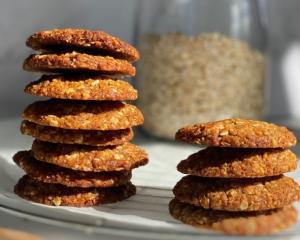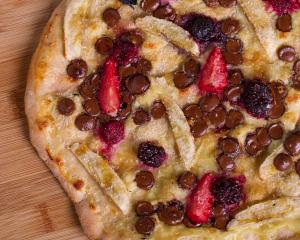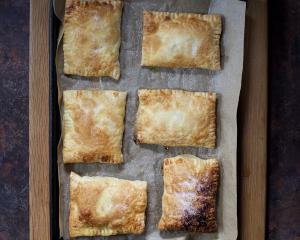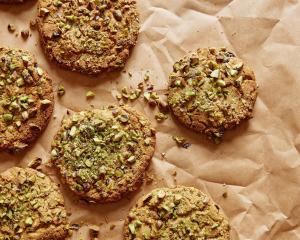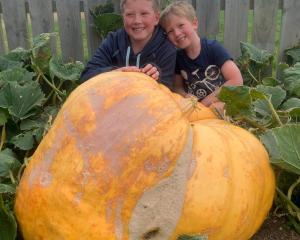
Wise words from those who should know - the Lea-Wilson family who brought back the craft of salt making to Anglesey, an island off the northwest coast of Wales.
Twenty years ago David and Alison Lea-Wilson were running an aquarium which showcased the marine life found around Anglesey but when tourism dropped off they started to look for ways they could use the seawater they used.
"So one weekend we made our first batch of sea salt in a saucepan on our old aga."
That led them to Japan to see how they made salt and a lot of fine tuning.
"The eureka moment was in Japan where I found a a museum of salt and a culture that valued sea salt," David says.
So he re-learned the craft of salt making that had existed on Anglesey until 1775 using seawater drawn from the Menai Strait around the island and creating Halen Mon or the Anglesey Sea Salt company.
Their saltwater goes through a mussel bed and sandbank to their saltcote where it is gently heated in a vacuum to boil at a low temperature. When the concentration of salt is high enough, they release it into shallow crystalisation tanks and leave it overnight for crystals to form. It is then harvested by hand before being rinsed in brine.
In 2014 it got European Union Protected Designation of Origin status joining Champagne and Parma ham.

"We have supplied royal weddings, Olympic ceremonies and even seasoned Barack Obama’s favourite caramels."
Their own food philosophy is based on sustainability like their business so they eat seasonally, support local producers wherever possible, eat less meat and grow as much of their food as they can in their kitchen garden.
In cooking, their best advice for using salt is to add it at different stages of the cooking process and keep tasting.
"Adding a small amount of salt at every stage will have more effect than adding a handful at the end. It will give you far more refined results and mean you use less overall."
Their book Sea Salt: A Perfectly Seasoned Cookbook tells the story of their business and features some of their favourite recipes and others created with the help of chef and friend Ana Shepherd, all of which use sea salt to make them taste their best - from raw seasoning, hot seasoning, brining, pickling and fermenting, curing and used with seafood and in sweets and drinks.
THE BOOK
Recipes and images are extracted from Sea Salt: A Perfectly Seasoned Cookbook by Lea-Wilson Family, published by White Lion Publishing, RRP: $55.

Prep time25 minutes, plus 15 minutes briningCook time 25 minutes
For the brined fish
500ml freshly boiled water
25g finer flaked sea salt
4 lemon sole fillets
2 celery sticks, leaves picked and stalks cut into 3cm pieces
1 lemon, peel pared (save the fruit to serve alongside the fish in wedges)
3 thyme sprigs
3 parsley stalks
3 dill stalks or fennel fronds
5 black peppercorns
50g plain flour
Butter and olive oil, for frying
Freshly ground black pepper
Lemon wedges, to serve
For the beans
1 round shallot or ½ banana shallot, finely chopped
2 Tbsp sherry vinegar
1½ tsp caster sugar
250g fine beans, trimmed
75g butter
50g almonds, toasted and roughly chopped
½ bunch of parsley, leaves only, finely chopped
Finer flaked sea salt and freshly ground black pepper
Method
Pour the boiled water into a heat-proof container (about 20x30cm) that will snugly hold the fish in an even layer. Add the salt and stir until it has completely dissolved. When the water is cool enough to hold your finger in for 5 seconds without discomfort, lay the fish in the container, so there is as little overlap as possible. Nestle the celery, lemon peel, herbs and peppercorns around the fish, cover with a clean tea towel and leave to brine at room temperature for 15 minutes.
Meanwhile, make a start on the beans. Toss the shallot in a small bowl with the vinegar, sugar and ¼ teaspoon salt to lightly pickle. Set aside.
Bring a pan of salted water to the boil over a high heat. Add the beans and return the pan to the boil. Cook for 4 minutes, then drain in a colander.
Fill the saucepan with cold water and submerge the beans under the water to stop them cooking and preserve their bright-green colour. Set aside.
Melt the butter in a small saucepan over a medium heat, then cook until the butter begins to foam and turn a couple of shades darker, tilting and swirling the pan so you can see the butter changing colour as it cooks under the foam. When the butter has browned and smells nutty, about 5 minutes, remove from the heat and use a wooden spoon to loosen the solids from the base of the pan. Browned butter can continue to cook for longer than you think - it’s only when it tastes bitter that it has gone too far. Set aside 2 tablespoons of the brown butter for the fish and leave the rest in the pan for the beans, off the heat.
Next, cook the fish. Lift the fish out of the brine and pat dry. Spread the flour out on a large plate and season generously with black pepper. Put the fish on the flour and turn until coated on both sides. Put two plates in a low oven (50degC) to warm.
Heat a knob of butter and a glug of oil in a large, heavy-based frying pan over a medium heat until the butter melts and starts to bubble. The base of the pan should be coated in a layer of fat to help crisp the fish skin and prevent it sticking.
Arrange the fish, two fillets at a time, skin-side down, in the pan and cook, without disturbing for 4 minutes. Use a spatula to gently turn the fish over and cook for another 90 seconds.
Keep the two cooked fillets warm on your pre-warmed plates, in the low oven, while you cook the other two.
Finally, finish the beans. Return the pan with most of the brown butter to a gentle heat. Stir through the beans for 3 to 4 minutes until warmed through, then remove from the heat and season with a pinch of salt.
Add the pickled shallots, 1 tablespoon of the pickling liquid, the almonds and chopped parsley. Taste and add more salt and/or pepper until it tastes just right to you.
Serve the fish on the warmed plates with the reserved brown butter drizzled over the top and the beans and lemon wedges alongside.

Crisp, seasoned breadcrumbs give way to a delicately balanced, pillowy interior in these excellent little croquettes.
We’ve used untraditional parsnips for a deeper flavour, but the characteristic crunch of the croquette remains, as well as the final flourish of flaked sea salt, which is essential.
Makes 20
Prep time 45 minutes, plus 20 minutes chilling
500g parsnips, peeled and cut into 4cm pieces
500g floury potatoes(such as agria), peeled and cut into 4cm pieces
1 bunch of spring onions, white and light green parts finely sliced
¼ tsp dried chilli flakes
115g strong hard cheese, such as Cheddar or Gruyere, grated
1 heaped tsp wholegrain mustard
25g butter, melted
4 medium eggs
75g plain flour
100g panko breadcrumbs
Vegetable oil, for deep-frying
1 lemon, cut into wedges
Finer flaked sea salt
Freshly ground black pepper
Flaked sea salt, to finish
Mace mayonnaise, to serve
Method
Put the parsnips and potatoes into a large saucepan and cover with cold water. Add 1 tablespoon of finer flaked salt and bring to the boil. Boil for 15 minutes, or until the parsnips and potatoes are tender throughout. Drain in a colander and leave to steam-dry for 15 minutes, then put into a large bowl and mash until smooth.
Stir in the spring onions, chilli flakes, cheese, mustard and melted butter, then season with ½ teaspoon finer flaked salt and a generous grind of black pepper. Taste the mixture and add more salt if you prefer. When you are happy with the seasoning, mix through one of the eggs to combine.
Beat the remaining eggs in a wide, shallow bowl. Spread the flour out on a large plate and season lightly with salt and pepper. Spread the breadcrumbs out on a separate plate. Line a couple of baking sheets with baking paper.
Using clean (or gloved) hands, divide the mixture into rough 45g balls, then shape into croquette cylinder shapes. Roll in the flour, then dip into the egg to coat and finally roll through the breadcrumbs until they are covered all over.
Put the coated croquettes on to the prepared baking sheet as you go. When you have shaped all the croquettes, chill in the fridge for 20 minutes to firm up.
Pour the vegetable oil for deep-frying into a large saucepan, so it comes 5cm up the sides of the pan. Clip a sugar thermometer on to the side of the pan and heat the oil over a medium-high heat.
Line another baking sheet with kitchen paper and preheat the oven to 120degC/100degC fan.
When the oil reaches 180degC on the thermometer, carefully lower the croquettes, in batches, into the hot oil and deep-fry for 2 to 3 minutes until crisp on the underside.
Use a slotted-spoon to gently flip them over and cook for another 2 to 3 minutes. Remove with a slotted-spoon and leave to drain on the lined baking sheet, then keep warm in the oven with the door slightly ajar (this will prevent them losing their distinctive crunchy exterior).
Repeat with the remaining, uncooked croquettes. They will keep warm for 1 hour before overcooking. When ready to serve, arrange on a platter with lemon wedges for squeezing over. Scatter over a generous pinch of flaked salt and serve with the mayonnaise.
Note: You can bake the croquettes instead, although the fried version is infinitely better.
Preheat the oven to 220degC/200degC fan. Drizzle the croquettes with olive oil and bake for about 20–25 minutes until piping hot and golden.

Cured egg yolks are one of those magic things you can do in the kitchen–tucking them away in the fridge to transform.
You can make them 24 hours in advance for a soft-centred yolk, as we have here, or five days in advance for a yolk that can be grated, not unlike bottarga (any leftovers can be grated over the buttermilk dressed salad, grilled asparagus or a spring risotto).
The pasta is topped with pangrattato, a "poor-man’s Parmesan" from Italy, which is rich in both flavour and texture.
Prep time: 25 minutes, plus 24 hours-5 days for curing
Cook time: 35 minutes

300g finer flaked sea salt
75g caster sugar
2 rosemary sprigs, leaves picked and chopped
Finely grated zest of 1 unwaxed lemon
4 medium egg yolks
For the pangrattato
2 Tbsp extra virgin olive oil
75g soft white breadcrumbs
½ tsp finer flaked sea salt
3 rosemary sprigs, leaves picked and finely chopped
1 garlic clove, finely chopped
Grated zest of ½ unwaxed lemon
For the pasta
1 cauliflower (about 500g), broken into florets, stalk roughly chopped
50g blanched almonds, roasted until golden brown
100ml double cream
3 Tbsp extra virgin olive oil
2 banana shallots, finely chopped
2 garlic cloves, finely sliced
3 anchovy fillets in oil
240g penne or rigatoni pasta
¼ whole nutmeg, grated
1 small bunch of parsley, leaves picked and finely chopped
Grated zest of ½ unwaxed lemon
Finer flaked sea salt

Method
For the egg yolks, mix the salt, sugar, chopped rosemary and lemon zest together in a large bowl. Tip half of the mixture into a large container with a lid, then use a spoon to make four round wells in the curing mixture, about the size of the yolks, leaving at least 2cm space between each well.
Lower the egg yolks into the wells and cover with the remaining salt mixture. Cover with a lid and leave in the fridge to cure for 24 hours for a soft-centred yolk, or five days for a firmer, grateable yolk.
Next, make the pangrattato. Heat the oil in a small frying pan over a medium heat. When it shimmers, add the breadcrumbs, salt, rosemary and garlic and stir to combine.
Cook, stirring frequently for 5-7 minutes until golden and crispy all over.
Transfer to a bowl, add the lemon zest and stir to combine. When the pangrattato is cool, transfer to a bowl or container and cover with an airtight lid. Store for up to a week at room temperature.
When the egg yolk is cured to your liking, bring a large saucepan of water to the boil.
Add a generous pinch of salt, then lower in the cauliflower and return to a rolling boil.
Cook for 5-7 minutes until very tender to the point of a sharp knife.
Remove from the heat and use a slotted spoon to transfer the cauliflower to a food processor with the almonds.
Leave the water in the pan to cook the pasta.

Heat the remaining oil in a small frying pan over a medium heat, add the shallots and a pinch of salt and fry, stirring frequently, for 3 minutes until the shallot is soft.
Add the garlic and anchovies and press down with a wooden spoon on the anchovies to break them up. Stir for another 2 minutes, by which time, the anchovies should look like they are "melted" and the garlic should be golden brown.
Return the pan of water to the boil and add another generous pinch of salt.
Cook the pasta according to the packet instructions, then drain, reserving 125ml of the pasta cooking water.
Return the pasta to the pan over a low heat. Pour in the shallot and anchovy mixture, the creamy cauliflower sauce, the reserved pasta water and grate over the nutmeg. Add the chopped parsley and stir until the thick sauce coats every piece of pasta. Cover with a lid and keep warm.
Remove the egg yolks from the fridge. Carefully lower into a bowl of cold water and rub away any salt that clings to the yolks. Each one should look like a glossy apricot. Pat dry before serving.
Spoon the pasta into warmed bowls and top with either a soft-centred egg yolk or grated egg yolk.
Sprinkle a tablespoon of pangrattato over each bowl with the rest in a bowl on the table.
Scatter with lemon zest and serve immediately.


